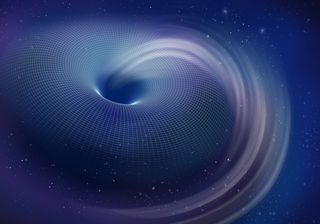Wormhole Time Travel 'Possible' (If You're a Photon)

The idea of traversable wormholes has been science fiction fodder since Einstein first theorized their existence with the formulation of his general theory of relativity, but do wormholes even exist in nature? Actually, we have no idea if they exist or not, but if they do, theoretical physicists have proposed that they could act as portals into the future and the past or connect two distant regions of space.
But before you grab your Grays Sports Almanac and get ready for some temporal mischief, there’s one huge caveat to this idea — only photons may travel… and even photons may be too much of a stretch for the hypothetical shortcut through spacetime.
ANALYSIS: Spooky Connection: Wormholes and the Quantum World
In a paper published to the arXiv preprint service (and submitted to the journal Physical Review D), theoretical physicist Luke Butcher of the University of Cambridge has revisited wormhole theory and potentially found a way to bridge these notoriously unstable entities.
In the late 1980s, physicist Kip Thorne, of the California Institute of Technology (Caltech), theorized that to make a wormhole ‘traversable’ — as in to actually make these spacetime shortcuts stable enough to travel through — some form of negative energy would be required. In the quantum world, this negative energy could come in the form of Casimir energy.
It is well known that if two perfectly smooth plates are held very close together in a vacuum, quantum effects between the plates will have a net repulsive (or attractive, depending on the plate configuration) effect between the two. This is caused by waves of energy being too large to fit between the plates, causing a net negative energy between the plates when compared with the surrounding “normal” space.
As realized by Thorne and his Caltech team, this Casimir energy could be applied to the neck of a wormhole, potentially holding it open long enough for something to pass through.
Sign up for the Live Science daily newsletter now
Get the world’s most fascinating discoveries delivered straight to your inbox.
NEWS: Time Travel? Don’t Forget to Pack Your Wormhole
Alas, we are talking about quantum-sized wormhole throats, meaning Marty McFly’s speeding DeLorean will be left revving in the 1985 parking lot, unable to squeeze through. But even if some quantum-sized traveler could pass through the wormhole’s neck, the wormhole would still likely collapse very quickly.
On reevaluating this scenario, Butcher has identified some more stable wormhole configurations and, in certain situations, the wormhole collapse could be prevented for an “arbitrarily long time.” But for this to happen, the wormhole needs to be very long and have a very narrow throat. In this case it seems possible that photons could traverse the wormhole.
“(T)he negative Casimir energy does allow the wormhole to collapse extremely slowly, its lifetime growing without bound as the throat-length is increased,” writes Butcher. “We find that the throat closes slowly enough that its central region can be safely traversed by a pulse of light.”
Butcher admits that although it’s not clear from his calculations whether the light pulse will be able to complete its journey from one end to the other, there is a tantalizing possibility for sending signals faster than the speed of light or even back in time.
ANALYSIS: Stephen Hawking’s Time Machine
“These results tentatively suggest that a macroscopic traversable wormhole might be sustained by its own Casimir energy, providing a mechanism for faster-than-light communication and closed causal curves.”
For the moment, this work is highly theoretical, but, as pointed out by Matt Visser of Victoria University of Wellington, New Zealand, in New Scientist on Tuesday, this research could renew interest in the study of wormholes and their potential spacetime-bridging capabilities.
So if we were to look for physical evidence of wormholes, could this research help us? Could we perhaps look out for be some kind of unique polarization of light that has traveled from another part of the Universe or some other time, appearing randomly in our local volume of spacetime? For answers to these questions, and as to whether this may spawn some kind of faster-then-light communications technology, we’ll likely have to wait until the theoretical physicists have crunched more numbers.
This article was first published on Discovery News.
Most Popular



